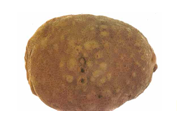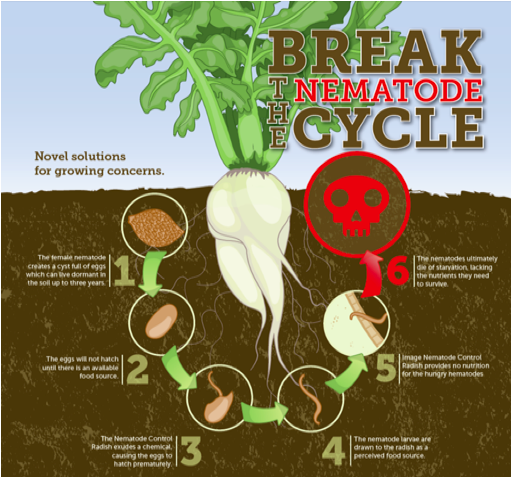Columbia Root Knot Nematodes (CRKN) is a pest of the Washington, Oregon, Idaho, and the San Louis Valley in Colorado potato crop. It can reduce yield and quality, causing economic loss to the grower. Damage to potatoes appears as rough, warty patches on the outside of the tuber, with golden-brown spots in the potato’s flesh from the dead females and their egg masses. These brown spots darken when the potato is fried, making the damage appear even more serious. In addition to damage to the potato tubers, above-ground foliage may become stunted, wilted or turn yellow as the root system is destroyed causing a reduction in yields.


CRKN can be managed by using biological and cultural practices. Planting Carwoodi Oil Seed Radish as a cover crop is a safe biological practice to control the CRKN in potato fields. In addition to reducing up to 90% of the nematode population, other benefits of using Carwoodi can be increased yields, improved soil tilth and water holding capacity, reduced nitrogen leaching into groundwater, weed suppression, reduced soil erosion by wind and water, and suppression of soil-borne diseases.
Breaking the nematode life cycle.
Carwoodi radish effectively reduces CRKN populations by up to 90% by stimulating CRKN hatch preventing the nematodes from completing their life cycle.
Here’s how:
- The female nematode creates a cyst full of eggs that can live in the soil for up to three years.
- The eggs do not hatch until there is an available food source.
- Carwoodi the nematode control radish exudes a chemical, causing the eggs to hatch prematurely.
- The nematode larvae are then drawn to the radish roots as a perceived food source.
- Carwoodi Nematode Controlling Radish provides NO nutrition for the hungry nematode larva.
- The nematodes ultimately die of starvation or do not reproduce because they lack the nutrients they need to survive.

The improved Carwoodi oil seed radish is a significant advancement over previous radish varieties. Carwoodi Radish features extremely high levels of glycosinalates in the top growth. When the radishes are mulched and worked into the soil, the glycosinalates break down and serve as a bio-fumigant further helping to reduce the population of CRKN.
As a catch crop and for nematode suppression, plant in the fall and allow the crop to grow for a minimum of 60 days to get maximum biomass production, root development, and nematode control. Carwoodi plants will winterkill at temperatures of 20 to 25 F. Plants should be terminated when flowering begins. It can be mowed or incorporated into the soil at or before the bloom stage to achieve maximum benefit and to prevent plants from going to seed. For maximum bio-fumigation results, mulch, incorporate, and then wait 3-5 weeks before planting the following crop. Carwoodi Radish is effective when utilized:
- After potato and carrot harvest, it is very effective at controlling Columbia Root Knot Nematodes (Meloidogyne chitwoodi).
- As a green manure crop grown in rotation with potatoes and carrots. It can reduce the amount of pesticides and synthetic fumigants required to control Columbia Root Knot Nematodes (Meloidogyne chitwoodi).
- As a green manure crop in potato production areas for controlling Potato Root Eelworm (Heterodera rostochiensis).
Not all oil seed radishes are created equal.
Nematode-controlling radishes are like a sniper, they are designed to control a specific nematode leaving the beneficial nematodes virtually untouched. To date, all the breeding efforts have come from Europe and as a result, the species of nematodes controlled are species that present a problem over there. At Grassland Oregon, we have just received our permit from APHIS, a two-year process, that will allow us to start working on varieties to target North American nematodes such as the Soy Bean Cyst Nematode.
Now’s the time to start getting your nematode-controlling radishes in so give GO Seeds a call to order before Carwoodi is gone for the season.
For a printable, PDF version of this blog, click below.
